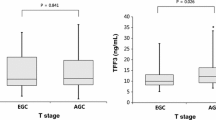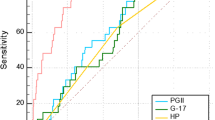Abstract
Background
A valid biomarker for predicting the presence of gastric cancer may contribute to reducing deaths from this disease. Although pepsinogen (PG) testing has been introduced as a predictor, its predictive power is not satisfactory. We examined whether serum trefoil factor (TFF) could be a non-endoscopic predictor of the presence of gastric cancer.
Methods
Gastric cancer patients who underwent preoperative endoscopy were sequentially recruited. Individuals who underwent a thorough medical checkup were enrolled as non-cancer controls. Serum levels of TFF1, TFF2, TFF3, Helicobacter pylori antibody, PG I, and PG II were examined.
Results
We studied 192 gastric cancer patients aged 64.3 ± 9.7 years and 1254 non-cancer controls aged 52.3 ± 12.4 years. In the age/gender-matched analysis (187 cases and 561 controls), significant relationships were demonstrated between gastric cancer presence and TFF3 (P < 0.0001), the PGI/II ratio (P < 0.0001), H. pylori antibody (P = 0.001), TFF1 (P = 0.012), and TFF2 (P = 0.020). The area under the receiver-operating characteristic curve for predicting gastric cancer presence was comparably high for all factors (0.893) and for the combination of TFF3 and the PG test (0.883), but was significantly (P < 0.0001) lower for the PG test alone (0.823). A positive PG test showed a sensitivity of 67% and specificity of 82%, whereas a combination of TFF3 and PG testing showed a sensitivity of 80% and specificity of 80% in predicting the presence of gastric cancer.
Conclusion
The combination of serum TFF3 and PG testing might be a valid non-endoscopic biomarker for predicting the presence of gastric cancer.





Similar content being viewed by others
References
Parkin DM, Bray F, Ferlay J, Pisani P. Global cancer statistics. CA Cancer J Clin. 2005;55:74–108.
Fukao A, Tsubono Y, Tsuji I, Hisamichi S, Sugahara N, Takano A. The evaluation of screening for gastric cancer in Miyagi Prefecture, Japan: a population-based case–control study. Int J Cancer. 1995;60:45–8.
Tashiro A, Sano M, Kinameri K, Fujita K, Takeuchi Y. Comparing mass screening techniques for gastric cancer in Japan. World J Gastroenterol. 2006;12:4873–4.
Miki K, Ichinose M, Kakei N, Yahagi N, Matsushima M, Tsukada S, et al. The clinical application of the serum pepsinogen I and II levels as a mass screening method for gastric cancer. Adv Exp Med Biol. 1995;362:139–43.
Kitahara F, Kobayashi K, Sato T, Kojima Y, Araki T, Fujino MA, et al. Accuracy of screening for gastric cancer using serum pepsinogen concentrations. Gut. 1999;44:693–7.
Dinis-Ribeiro M, Yamaki G, Miki K, Costa-Pereira A, Matsukawa M, Kurihara M. Meta-analysis on the validity of pepsinogen test for gastric carcinoma, dysplasia or chronic atrophic gastritis screening. J Med Screen. 2004;11:141–7.
Watabe H, Mitsushima T, Yamaji Y, Okamoto M, Wada R, Kokubo T, et al. Predicting the development of gastric cancer from combining Helicobacter pylori antibodies and serum pepsinogen status: a prospective endoscopic cohort study. Gut. 2005;54:764–8.
Taupin D, Podolsky DK. Trefoil factors: initiators of mucosal healing. Nat Rev Mol Cell Biol. 2003;4:721–32.
Perry JK, Kannan N, Grandison PM, Mitchell MD, Lobie PE. Are trefoil factors oncogenic? Trends Endocrinol Metab. 2008;19:74–81.
Dhar DK, Wang TC, Tabara H, Tonomoto Y, Maruyama R, Tachibana M, et al. Expression of trefoil factor family members correlates with patient prognosis and neoangiogenesis. Clin Cancer Res. 2005;11:6472–8.
Nomura S, Baxter T, Yamaguchi H, Leys C, Vartapetian AB, Fox JG, et al. Spasmolytic polypeptide expressing metaplasia to preneoplasia in H. felis-infected mice. Gastroenterology. 2004;127:582–94.
Peterson AJ, Menheniott TR, O’Connor L, Walduck AK, Fox JG, Kawakami K, et al. Helicobacter pylori infection methylates and silences trefoil factor 2 leading to gastric tumor development in mice and humans. Gastroenterology. 2010;139:2005–17.
Miki K. Gastric cancer screening using the serum pepsinogen test method. Gastric Cancer. 2006;9:245–53.
Samloff IM, Varis K, Ihamaki T, Siurala M, Rotter JI. Relationships among serum pepsinogen I, serum pepsinogen II and gastric mucosal histology. A study in relatives of patients with pernicious anemia. Gastroenterology. 1982;83:204–9.
Oishi Y, Kiyohara Y, Kubo M, Tanaka K, Tanizaki Y, Ninomiya T, et al. The serum pepsinogen test as a predictor of gastric cancer: the Hisayama study. Am J Epidemiol. 2006;163:629–37.
Leung WK, Yu J, Chan FK, To KF, Chan MW, Ebert MP, et al. Expression of trefoil peptides (TFF1, TFF2, and TFF3) in gastric carcinomas, intestinal metaplasia, and non-neoplastic gastric tissues. J Pathol. 2002;197:582–8.
Lao-Sirieix P, Boussioutas A, Kadri SR, O’Donovan M, Debiram I, Das M, et al. Non-endoscopic screening biomarkers for Barrett’s oesophagus: from microarray analysis to the clinic. Gut. 2009;58:1451–9.
Bignotti E, Ravaggi A, Tassi RA, Calza S, Rossi E, Falchetti M, et al. Trefoil factor 3: a novel serum marker identified by gene expression profiling in high-grade endometrial carcinomas. Br J Cancer. 2008;99:768–73.
Vestergaard EM, Borre M, Poulsen SS, Nexø E, Tørring N. Plasma levels of trefoil factors are increased in patients with advanced prostate cancer. Clin Cancer Res. 2006; 12(3 Pt 1):807–12.
Vestergaard EM, Nexø E, Tørring N, Borre M, Ørntoft TF, Sørensen KD. Promoter hypomethylation and upregulation of trefoil factors in prostate cancer. Int J Cancer. 2010;127:1857–65.
Morson BC, Dawson IMP, Day DW, Jass JR, Price AB, Williams GT, et al. Malignant epithelial tumours. In: Morson and Dawson, editors. Gastrointestinal pathology. 3rd ed. London: Blackwell Scientific Publications; 1990. p. 143–69.
He XX, Yang J, Ding YW, Liu W, Shen QY, Xia HH. Increased epithelial and serum expression of macrophage migration inhibitory factor (MIF) in gastric cancer: potential role of MIF in gastric carcinogenesis. Gut. 2006;55:797–802.
Acknowledgments
The authors would like to thank Ms. Keiko Hayakawa for her helpful assistance.
Conflict of interest
None.
Author information
Authors and Affiliations
Corresponding author
Rights and permissions
About this article
Cite this article
Kaise, M., Miwa, J., Tashiro, J. et al. The combination of serum trefoil factor 3 and pepsinogen testing is a valid non-endoscopic biomarker for predicting the presence of gastric cancer: a new marker for gastric cancer risk. J Gastroenterol 46, 736–745 (2011). https://doi.org/10.1007/s00535-011-0396-8
Received:
Accepted:
Published:
Issue Date:
DOI: https://doi.org/10.1007/s00535-011-0396-8




